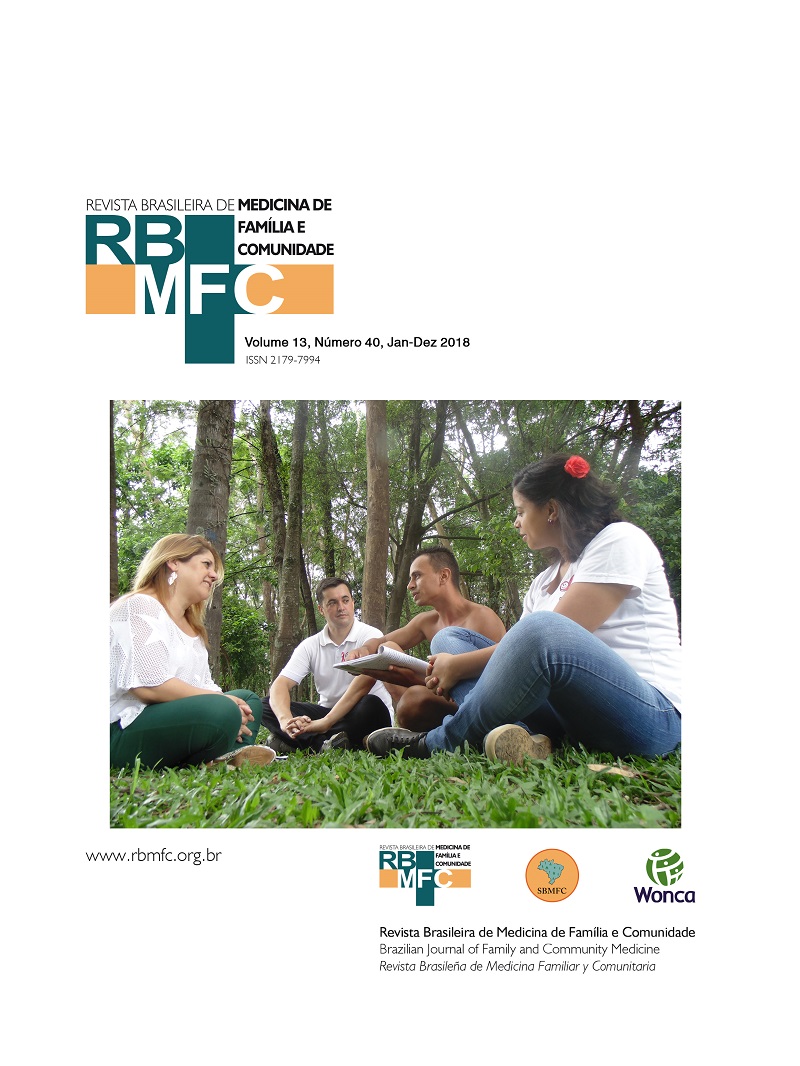A methodological proposal for the preparation of clinical reviews
DOI:
https://doi.org/10.5712/rbmfc13(40)1871Keywords:
Review Literature as Topic, Methodology, Family Practice, Evidence-Based MedicineAbstract
Clinical reviews are evidence summaries with broad scope and orientation to professional practice, occupying one of the highest levels in the pyramid of evidence-based health care. Based on this pyramid, we reflect on instructions to the authors of journals in family medicine to present instructions on how to write clinical reviews. The instructions cover how to search, appraise, synthesize and analyze clinical evidence, and how to plan and report the review. We hope these instructions will help improve the quantity and quality of clinical reviews in family medicine in Brazil.
Downloads
Metrics
References
Sackett DL, Rosenberg WM, Gray JA, Haynes RB, Richardson WS. Evidence based medicine: what it is and what it isn’t. BMJ. 1996;312(7023):71-2. https://doi.org/10.1136/bmj.312.7023.71 DOI: https://doi.org/10.1136/bmj.312.7023.71
Djulbegovic B, Guyatt GH. Progress in evidence-based medicine: a quarter century on. Lancet. 2017;390(10092):415-23. https://doi.org/10.1016/S0140-6736(16)31592-6 DOI: https://doi.org/10.1016/S0140-6736(16)31592-6
Smith R, Rennie D. Evidence-based medicine—an oral history. JAMA. 2014;311(4):365-7. https://doi.org/10.1001/jama.2013.286182 DOI: https://doi.org/10.1001/jama.2013.286182
Guyatt GH, Meade MO, Jaeschke RZ, Cook DJ, Haynes RB. Practitioners of evidence based care. Not all clinicians need to appraise evidence from scratch but all need some skills. BMJ. 2000;320(7240):954-5. https://doi.org/10.1136/bmj.320.7240.954 DOI: https://doi.org/10.1136/bmj.320.7240.954
Ely JW, Osheroff JA, Ebell MH, Chambliss ML, Vinson DC, Stevermer JJ, et al. Obstacles to answering doctors’ questions about patient care with evidence: qualitative study. BMJ. 2002;324(7339):710. https://doi.org/10.1136/bmj.324.7339.710 DOI: https://doi.org/10.1136/bmj.324.7339.710
Green ML, Ruff TR. Why do residents fail to answer their clinical questions? A qualitative study of barriers to practicing evidence-based medicine. Acad Med. 2005;80(2):176-82. https://doi.org/10.1097/00001888-200502000-00016 DOI: https://doi.org/10.1097/00001888-200502000-00016
Alper BS, Haynes RB. EBHC pyramid 5.0 for accessing preappraised evidence and guidance. Evid Based Med. 2016;21(4):123-5. https://doi.org/10.1136/ebmed-2016-110447 DOI: https://doi.org/10.1136/ebmed-2016-110447
Institute of Medicine (U.S.). Clinical practice guidelines we can trust. Washington, DC: National Academies Press; 2011.
Grant MJ, Booth A. A typology of reviews: an analysis of 14 review types and associated methodologies. Health Inf Libr J. 2009;26(2):91-108. https://doi.org/10.1111/j.1471-1842.2009.00848.x DOI: https://doi.org/10.1111/j.1471-1842.2009.00848.x
Haynes RB, Cotoi C, Holland J, Walters L, Wilczynski N, Jedraszewski D, et al.; McMaster Premium Literature Service (PLUS) Project. Second-order peer review of the medical literature for clinical practitioners. JAMA. 2006;295(15):1801-8. https://doi.org/10.1001/jama.295.15.1801 DOI: https://doi.org/10.1001/jama.295.15.1801
Vetter N. What is a clinical review? Rev Clin Gerontol. 2003;13(2):103-5. https://doi.org/10.1017/S0959259803013212 DOI: https://doi.org/10.1017/S0959259803013212
O’Connor D, Green S, Higgins JPT. Defining the review question and developing criteria for including studies. In: Higgins JPT, Green S, Cochrane Collaboration, eds. Cochrane handbook for systematic reviews of interventions. Cochrane Book Series. Chichester (UK); Hoboken (USA): Wiley-Blackwell; 2008.
Ebell MH, Siwek J, Weiss BD, Woolf SH, Susman J, Ewigman B, et al. Strength of recommendation taxonomy (SORT): a patient-centered approach to grading evidence in the medical literature. J Am Board Fam Pract. 2004;17(1):59-67. https://doi.org/10.3122/jabfm.17.1.59 DOI: https://doi.org/10.3122/jabfm.17.1.59
Guyatt GH, Oxman AD, Vist GE, Kunz R, Falck-Ytter Y, Alonso-Coello P, et al.; GRADE Working Group. GRADE: an emerging consensus on rating quality of evidence and strength of recommendations. BMJ. 2008;336(7650):924-6. https://doi.org/10.1136/bmj.39489.470347.AD DOI: https://doi.org/10.1136/bmj.39489.470347.AD
Guyatt GH, Oxman AD, Kunz R, Jaeschke R, Helfand M, Liberati A, et al.; GRADE Working Group Incorporating considerations of resources use into grading recommendations. BMJ. 2008;336(7654):1170-3. https://doi.org/10.1136/bmj.39504.506319.80 DOI: https://doi.org/10.1136/bmj.39504.506319.80
Guyatt GH, Oxman AD, Kunz R, Vist GE, Falck-Ytter Y, Schünemann HJ; GRADE Working Group. What is “quality of evidence” and why is it important to clinicians? BMJ. 2008;336(7651):995-8. https://doi.org/10.1136/bmj.39490.551019.BE DOI: https://doi.org/10.1136/bmj.39490.551019.BE
Brasil. Ministério da Saúde. Secretaria de Ciência, Tecnologia e Insumos Estratégicos. Departamento de Ciência e Tecnologia. Diretrizes metodológicas: Sistema GRADE – Manual de graduação da qualidade da evidência e força de recomendação para tomada de decisão em saúde. Brasília: Ministério da Saúde; 2014.
Guyatt GH, Oxman AD, Schünemann HJ, Tugwell P, Knottnerus A. GRADE guidelines: A new series of articles in the Journal of Clinical Epidemiology. J Clin Epidemiol. 2011;64(4):380-2. https://doi.org/10.1016/j.jclinepi.2010.09.011 DOI: https://doi.org/10.1016/j.jclinepi.2010.09.011
Agoritsas T, Merglen A, Heen AF, Kristiansen A, Neumann I, Brito JP, et al. UpToDate adherence to GRADE criteria for strong recommendations: an analytical survey. BMJ Open. 2017;7(11):e018593. https://doi.org/10.1136/bmjopen-2017-018593 DOI: https://doi.org/10.1136/bmjopen-2017-018593
Siwek J, Gourlay ML, Slawson DC, Shaughnessy AF. How to Write an Evidence-Based Clinical Review Article. Am Fam Physician. 2002;65(2):251-8.
Braga R, Melo M. Como fazer uma revisão baseada na evidência. Rev Port Med Geral Fam. 2009;25(6):660-6. DOI: https://doi.org/10.32385/rpmgf.v25i6.10691
Savassi LCM, Oliveira ACD, Dias RB. Proposta de metodologia de busca de evidências em Atenção Primária à Saúde: o exemplo da osteoporose em homens. Rev Bras Med Fam Comunidade. 2008;4(15):205-21. https://doi.org/10.5712/rbmfc4(15)177 DOI: https://doi.org/10.5712/rbmfc4(15)177
Norman AH. A RBMFC e o desafio da educação médica continuada. Rev Bras Med Fam Comunidade. 2013;8(26):3-5. https://doi.org/10.5712/rbmfc8(26)719 DOI: https://doi.org/10.5712/rbmfc8(26)719
Downloads
Published
How to Cite
Issue
Section
License
By submitting a manuscript to the RBMFC, authors retain ownership of the copyright in the article, and authorize RBMFC to publish that manuscript under the Creative Commons Attribution 4.0 license and identify itself as the vehicle of its original publication.















